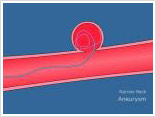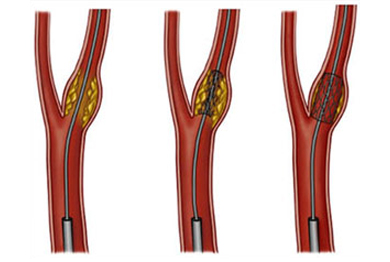 Aneurysms are small outpouchings from of vessel wall. It is believed that the vessel is weak at this area. This small outpouching has a tendency to grow reducing an extremely friable or which is liable to burst at any moment.
Aneurysms are small outpouchings from of vessel wall. It is believed that the vessel is weak at this area. This small outpouching has a tendency to grow reducing an extremely friable or which is liable to burst at any moment.
When an aneurysm ruptures in the brain, the patient experiences headache of such severity that it is termed thunder clap headache.Close to 20 % of patients never reach the hospital at all. Another 20% will die in the next two weeks unless the aneurysm is treated.Aneurysms which have bled have a very high likelihood of bleeding again in the next few days and definite treatment for the same should be given at the earliest.
Endovascular coiling is an innovative technique where, this weak area in the blood vessel of the brain is repaired by packing this this outpouching with multiple medical coils which obliterates the sac completely. The procedure is done by a small puncture in the blood vessel of the thigh without opening the brain and skull.
Procedures Details
SAH and Aneurysm
When an aneurysm ruptures in the brain, the patient experiences headache of such severity that it is termed thunder clap headache.Close to 20 % of patients never reach the hospital at all. Another 20% will die in the next two weeks unless the aneurysm is treated.Aneurysms which have bled have a very high likelihood of bleeding again in the next few days and definite treatment for the same should be given at the earliest.
Management
One of the common causes of stroke is a occlusion of a blood vessel supplying a vital part of the brain. They are commonly caused by a small blood clot that develops at the site of narrowing in the carotid or vertebral arteries, which are the main blood vessels that supply the brain. the clot then detaches it self and migrates into the smaller intracranial vessels along the direction of flow.
Narrowing of these vessels are commonly caused by atherosclerosis. In this condition deposition of fat and fibrous tissue results in reduction in size of the lumen which in turn produces turbulence of blood across this segment. Another reason a blood vessel can be narrow is secondary to a type of inflammation called arteritis. This is commonly seen in young women.
Often carotid stenosis may have no symptoms at all and may be detected during a Doppler ultrasound of the neck. At times the patient may experience intermittent numbness or weakness of one half of the body or of a single extremity. Patients also may experience blurring or blindness in one eye which may last for a few seconds. This condition is called TIA.
Color Doppler evaluation of the neck vessels is a simple and accurate way to establish the diagnosis of carotid stenosis. Once this diagnosis is made ,the patient should ideally receive treatment which could either be surgical or a non- surgical -carotid stentingand if the stenosis is more than 65%.
Technique :
 Carotid stenting involves taking a fine tube [catheter] under imaging guidance through small puncture in the blood vessel of the thigh into the suspected blood vessel that supplies the brain. This is performed under sophisticated imaging guidance. An angiogram is performed to confirm the diagnosis that is made by Doppler.
Carotid stenting involves taking a fine tube [catheter] under imaging guidance through small puncture in the blood vessel of the thigh into the suspected blood vessel that supplies the brain. This is performed under sophisticated imaging guidance. An angiogram is performed to confirm the diagnosis that is made by Doppler.
After this a fine wire which has a specialized medical filter is navigated across the narrow segment and placed beyond it in the normal vessel. The narrow segment is then dilated with a balloon catheter. The balloon is then exchanged for a fine metalmesh (stent). Further balloon dilatation is performed if the lumen continues to be narrow after stenting. Following the procedure the filter is captured in a specialized tube and removed. The puncture site in the groin is then compressed till hemostasis is achieved or an Angio-Seal device is used to prevent further bleeding.
There is enough evidence in the literature to conclusively said that carotid stenting is in no way inferior to open surgery for carotid stenosis.
Narrowing of the vertebral artery can also be treated in the same way. Here, unlike carotid stenting interventional radiology is the only way reestablished normal flow. Surgery of the vertebral arteries is difficult and dangerous.